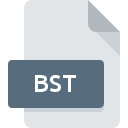.BST File Extension

BibTeX Style Document
| Developer | Update Soon |
| Popularity | |
| Category | Misc Files |
| Format | .BST |
| Cross Platform | Update Soon |
What is an BST file?
The .BST file extension is commonly associated with BibTeX Style files, a crucial component in the world of academic and scientific writing.
BibTeX is a reference management software used in conjunction with LaTeX, a typesetting system. .BST files play a vital role in defining how bibliographic references are formatted and displayed in LaTeX documents.
This guide explores the origin, history, file structure, technical specifications, and practical uses of .BST files, along with their advantages and disadvantages, and offers insights into converting and opening them on various operating systems.
More Information.
BibTeX was introduced in 1985 as part of Lamport’s LaTeX typesetting system. The introduction of .BST files allowed users to create custom bibliographic styles tailored to their specific needs.
Initially, the purpose of .BST files was to provide flexibility in the presentation of bibliographic data, catering to different citation styles required by academic journals, conferences, and institutions.
The ability to define various styles, such as APA, MLA, and Chicago, using .BST files quickly became an essential feature for researchers and authors who needed to adhere to specific formatting guidelines.
Over time, the use of .BST files expanded beyond traditional academic settings, becoming a standard in any field that relies on LaTeX for document preparation.
Origin Of This File.
The .BST file extension has its roots in the development of BibTeX, a tool created by Leslie Lamport in the 1980s.
Lamport developed BibTeX as an auxiliary tool for LaTeX, which itself was a revolutionary typesetting system developed by Donald Knuth.
The primary goal of BibTeX was to streamline the process of managing bibliographic references and citations within LaTeX documents. .BST files emerged as a means to define and customize the style in which these references were formatted.
File Structure Technical Specification.
A .BST file is essentially a plain text file that contains a set of formatting rules and functions used by BibTeX to produce bibliographic references.
The structure of a .BST file is defined by a set of BibTeX style definitions written in a specialized programming language. Here are some key components of a .BST file:
- Header Section: This part of the file includes metadata about the style, such as its name, author, and version. It may also contain comments or instructions for users.
- Function Definitions: .BST files contain a series of functions that determine how different types of bibliographic entries (e.g., articles, books, theses) are formatted. These functions control aspects such as the order of fields, punctuation, and formatting of author names.
- Format Specifications: This section defines the specific formatting rules for various elements of the bibliography, including titles, publication dates, and page numbers. It often includes LaTeX commands that dictate how the final output will appear.
- Sorting and Filtering Rules: .BST files also include rules for sorting and filtering bibliographic entries based on criteria such as author names or publication dates.
How to Convert the File?
Converting a .BST file to a different format is generally not straightforward, as .BST files are specifically designed for use with BibTeX and LaTeX. There are a few approaches you might consider:
- Exporting Bibliographic Data: If the goal is to extract bibliographic data from a .BST file for use in another reference management system, you can use BibTeX tools to generate a
.bibfile (BibTeX database file) that contains the bibliographic information. This.bibfile can then be imported into other reference management tools. - Custom Conversion Scripts: For more advanced users, custom scripts can be written to convert .BST files into other formats. These scripts would need to parse the .BST file and translate the formatting instructions into the desired format.
- Manual Formatting: In some cases, you may need to manually format bibliographic entries based on the instructions in the .BST file if conversion tools are not available.
Advantages And Disadvantages.
Advantages:
- Customization: One of the main advantages of .BST files is the ability to customize bibliographic styles to meet specific formatting requirements. Users can create or modify styles to conform to various citation standards.
- Integration with LaTeX: .BST files work seamlessly with LaTeX, a powerful typesetting system used for creating professional-quality documents. This integration ensures that bibliographic references are consistently formatted.
- Flexibility: The .BST format allows for a high degree of flexibility in defining how references are presented. This is particularly useful for researchers who need to adapt their bibliography to different publication standards.
Disadvantages:
- Complexity: Writing and editing .BST files can be complex, especially for users who are not familiar with the BibTeX programming language. This complexity may pose a barrier to customization for some users.
- Limited Support: While .BST files are widely used in academic and scientific communities, they may not be as well supported in other types of document preparation systems. This can limit their utility for users outside these fields.
How to Open BST?
Open In Windows
- To open a .BST file on Windows, users can use any text editor, such as Notepad or Notepad++. For more advanced editing, users might prefer an Integrated Development Environment (IDE) like TeXstudio or TeXworks, which provide syntax highlighting and other features for working with LaTeX and BibTeX files.
Open In Linux
- Linux users can open .BST files using text editors like Vim, Emacs, or Gedit. For a more integrated LaTeX experience, tools such as Kile or Texmaker can be used to edit and manage .BST files efficiently.
Open In MAC
- On macOS, .BST files can be opened with text editors like TextEdit or more specialized LaTeX editors such as TeXShop or MacTeX. These tools provide a user-friendly interface for editing and managing .BST files.











